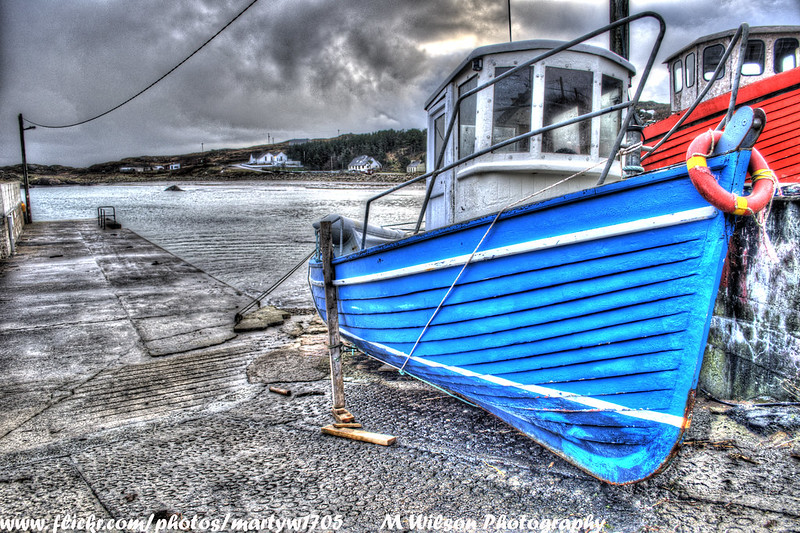Will Europe manage to save its fish stocks?
And what will happen to the fishermen?
Do Irish fishermen have a future?
From Worldcrunch by Eric Albert
The battle is not totally over, and total victory remains uncertain.
But the fishermen from
Arranmore have managed to make Brussels sway.
This handful of diehard Irish fishermen is slowly managing to lift
Europe’s fishing ban, which has been stifling the economy of this remote
island for the past seven years.
Arranmore is located off the coast of northwestern Ireland.
The wind
here is merciless, and a good many boats have been crushed on the reefs
surrounding it.
Fishing has traditionally been the main source of work here, and it is the heart of life on this 22-square-kilometer island.
Things changed dramatically when in 2006, following a directive from
the Brussels-based European Commission, Dublin decided to ban
salmon fishing
in a bid to stop the decline of fish stocks.
Another bill two years
later outlawed all net fishing around the country, in a zone nicknamed
“VIa.” The ban affected numerous species, including cod and whiting,
allowing only the fishing of crabs and lobsters.
Arranmore island aerial view
The sea as a unique resource
The Irish government was offering fishermen all over the country
financial compensation. Most of them accepted, but not on Arranmore.
Along with its neighbors of the islands of Tory and Inisbofin,
Arranmore rebelled against the authorities, refusing to sign a
declaration stating they would stop fishing salmon forever.
The proposed government deal was unacceptable for the strapping Neily
Kavenagh.
Despite his short and snappy sentences, the 48-year-old
fisherman struggles to find words that are strong enough to condemn this
attempt to “buy [him] off.”
“They offered me 40,000 euros ($54,000).
It’s a lot of money. But my dad got this salmon fishing license in the
1950s. I wanted to pass it on to my own child,” he says.
The
fishermen
came together in 2007.
Hugh Rodgers, one of the group’s leaders,
remembers it as if it were yesterday.
“We managed to convince everybody
save one not to accept the compensation,” he recalls.
“For us, it was
self-evident. We have no factories, and tourists come only in summer.
The sea is our own resource. It should be for the locals, and we should
have the right to reap our own harvest.”
Arranmore fishing boat
In 7 years, the number of operating boats dropped 40% on Arranmore
An “attack” on Arranmore’s life
The Arranmore fishermen use traditional methods and say they have
nothing to do with the drop in fish populations.
Because their boats are
scarcely over 15 meters long (50 feet), they hardly venture into the
open sea.
On the other hand, they saw an armada of factory boats —
mainly from Spain, Holland and France — coming just a few kilometers
from their coast after they had bought Irish fishing rights.
“These guys
can keep working the way they do far from the coast, even today,”
Kavenagh says angrily.
“As for us, we have nothing left.”
For him, the
fishing ban is an “attack” on the very life of Arranmore.
The
island inhabitants have asked for a protection similar to that of an oppressed minority.
Arranmore island with the Marine GeoGarage (UKHO chart)
On the small island, the ban’s impact was rapidly felt.
In seven
years, as the few rusty wrecks in the harbor show, the number of
operating boats dropped 40%.
The population fell from 768 to 487.
A
hotel, a pub and three shops have closed.
One of the two primary schools
only has 12 pupils left and its days are probably numbered.
“If it goes on like this, there will be nothing on Arranmore in 10
years,” says a worried Loïc Jourdain. The French director has been
filming the island’s revolt from the beginning and is working on a
documentary expected to be released in 2014.
Having followed the
fishermen for so long, he remembers their face-to-face meetings with
politicians and lobbyists.
“A lot of them went to Brussels and Dublin to
pressure the authorities.
Even the priest, a very influential man, went along with them.”
Little
by little, they were joined in their fight by other European islands,
and the balance started to shift in their favor.
“I will violate the law before I give up on fishing”
In the last few months, the fishermen have won their first victories.
In May, the European reform of the common fisheries policy recognized
the importance of protecting local communities as well
as the fish.
The new directive supports small-scale fishing less than 12 nautical miles from the coast.
The Irish government has also agreed to loosen bans on the “VIa”
zone.
By November, new licenses are to be given to boats under 15 meters
long (50 feet).
But no changes are afoot for salmon fishing, even though it is the
most economically constraining ban.
Though Deputy Prime Minister Eamon
Gilmore had indicated support for the
fishermen when he was in the opposition, since he entered the government in 2011 he has been silent on this issue.
On Arranmore, the fishermen keep saying they
won’t give up.
They have vowed to keep the pressure up, as they believe it’s their
only chance for the island and its residents to survive.
In a cold and
determined voice, Neily Kavenagh warns, “I will violate the law before I
give up on fishing.”
Links :


















